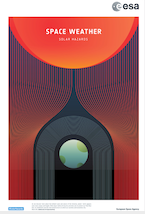Speaker
Description
University of Turku (UTU) is developing CubeSat compatible instrumentation for observing and monitoring near-Earth particle radiation environment within the framework of Finnish Centre of Excellence in Research of Sustainable Space (FORESAIL). The first instrument of the suite, Radiation Monitor (RADMON), is making observations of energetic electrons (>1.5 MeV) and protons (>10 MeV) aboard Aalto-1, a 3-U CubeSat in sun-synchronous Low Earth Orbit (~500 km), since July 2017. RADMON is a compact low-cost instrument consisting of a detector unit and three printed circuit boards (analog board, digital board, power supply board) altogether taking about 0.4 U of space. The mass is less than 400 g and the power consumption about 1 W. The detector unit consists of a Si detector of 350 µm thickness plus a 1 cm$^3$ cubic CsI(Tl) scintillator with photodiode readout, both enclosed inside a brass frame with an Al window defining the nominal aperture of the instrument. FPGA-based digital signal processing produces two pulse heights – one per detector for each incident particle – used for particle identification and energy determination. The instrument produces electron and proton counting rates in five and nine channels, respectively, which have responses that allow for the determination of the integral flux at several threshold energies per species. RADMON operations aboard Aalto-1 have produced valuable data, which are presently utilized to improve the design for future applications of the instrument in space weather monitoring constellations (see Huovelin et al., this workshop).
The second instrument under development at UTU is Particle Telescope (PATE), which will be carried by the FORESAIL-1 mission, a 3-U CubeSat to be launched in polar Low Earth Orbit in 2020. PATE measures the differential fluxes at electron [proton] energies of 80–800 keV [0.3–10 MeV] in seven [nine] differential channels and in one [two] integral channel[s] above 800 keV [10 MeV]. PATE consists of housing, two detector units, amplifier boards, signal processing boards and boards for generating voltages and housekeeping measurements. The mass of the instrument is 1.2 kg, the envelope is 1.4 U and the power consumption close to 3 W. The two detector units consist of stacks of Si detectors that are passively collimated to observe particle fluxes inside orthogonal narrow view cones, to allow an accurate measurement of pitch-angle distributions on-board rotating platforms. The specific application of PATE aboard FORESAIL-1 is the accurate determination of precipitating electron fluxes in the outer-belt region. Further uses in various space weather missions are also in planning. The instrument is presently at TRL 4, with a prototype tested in the laboratory and a qualification model being assembled. After the qualification campaign PATE will reach TRL 6 by the end of 2019. A more compact (less well-collimated) version of the instrument is presently developed for space weather purposes. It will have a very similar detector system and electronics, but the mechanical structure is more integrated, giving an envelope of 0.75 U and a mass of 0.9 kg.

